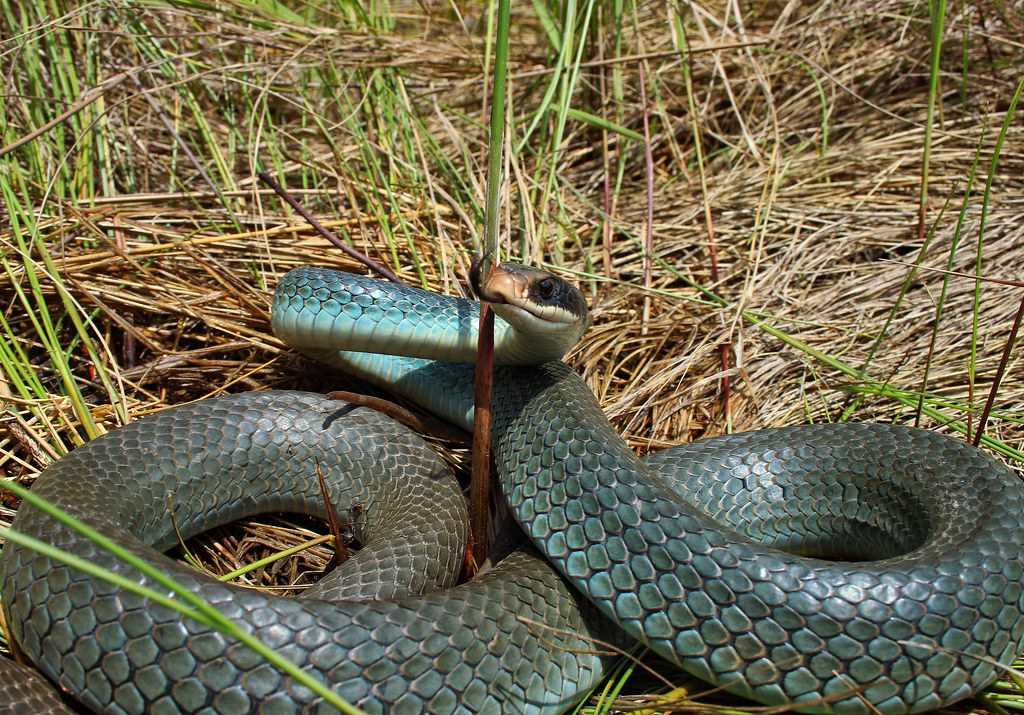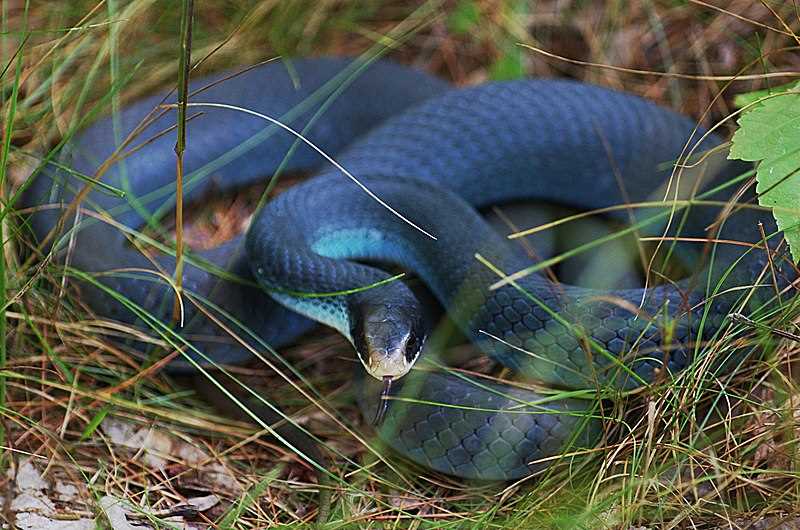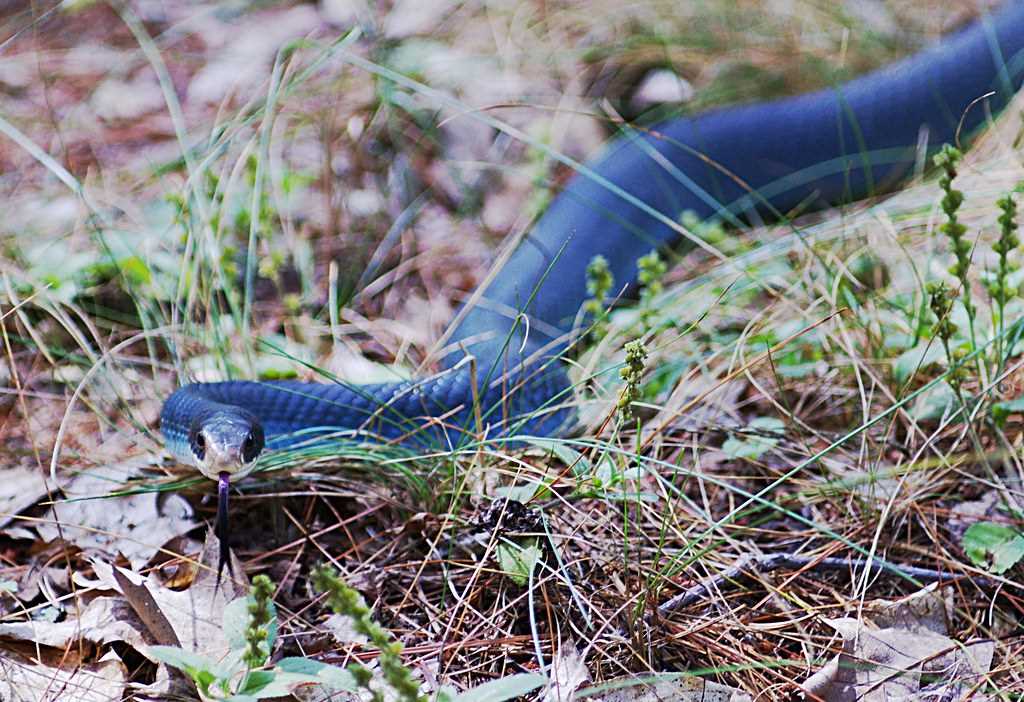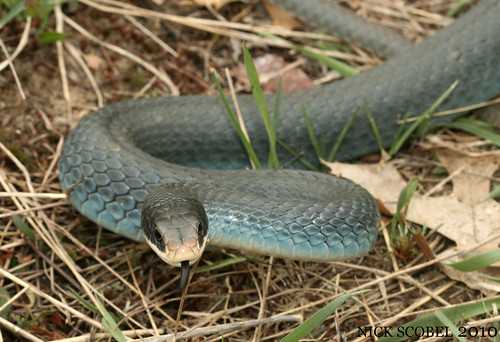As a predator, the Michigan Blue Racer is perfectly adapted to its environment. With a slender body and a long tail, it is built for speed and agility. Its powerful muscles allow it to quickly chase down its prey, which primarily consists of small rodents and other reptiles. This snake’s lightning-fast strikes make it an incredibly efficient predator.
Unfortunately, despite its impressive characteristics, the Michigan Blue Racer is considered an endangered species. Habitat destruction and fragmentation, pollution, and road mortality are threatening its population. Conservation efforts are crucial to protect this unique and valuable snake species from extinction.
The Michigan Blue Racer is a unique and fascinating reptile native to the state of Michigan. Known for its incredible speed and striking blue coloration, this snake is a true marvel of nature. However, despite its beauty, the Michigan Blue Racer is currently listed as an endangered species.
Characteristics

The Michigan Blue Racer is a medium-sized snake, averaging around 3 to 5 feet in length. Its vibrant blue color is what sets it apart from other snakes in the region. The blue hue of its scales is a result of a specific structural arrangement of pigment cells, giving it a dazzling appearance.
The snake’s body is slender and sleek, allowing it to move swiftly through its natural habitat of grassy fields and open woodlands. Its eyes are large and round, providing excellent vision to aid in hunting and navigation. Additionally, the Michigan Blue Racer possesses a long, tapering tail that helps it maintain balance and agility while in motion.
Behavior

The Michigan Blue Racer is known for its incredible speed, earning it the title of one of the fastest snakes in North America. It can reach speeds of up to 15 miles per hour, allowing it to quickly escape from predators or chase down prey. This remarkable agility and speed make it a formidable predator in its ecosystem.
The diet of the Michigan Blue Racer consists mainly of small mammals, such as mice and voles, as well as birds and amphibians. It is an important regulator of rodent populations, contributing to the balance of its ecological community.
During the winter months, the Michigan Blue Racer hibernates to survive the cold temperatures. It seeks out underground dens or other sheltered locations to ride out the winter, emerging in the spring when temperatures rise.
Conservation
Due to habitat loss, fragmentation, and human activities, the Michigan Blue Racer population has declined significantly, resulting in its endangered status. Conservation efforts have been put in place to protect and restore its natural habitat and raise awareness about the importance of preserving this unique species.
The Michigan Blue Racer plays an important role in its ecosystem as both a predator and a prey species. Its conservation is crucial for maintaining the balance and health of the Michigan wildlife community.
Characteristics of the Michigan Blue Racer

The Michigan Blue Racer, a species of snake native to the state of Michigan, is a fascinating and unique reptile. It is known for its distinctive blue coloration and slender body, making it easily recognizable among other snake species. This snake is commonly found in grasslands and open areas, where its camouflage and speed make it an effective predator.
One of the notable characteristics of the Michigan Blue Racer is its tail. Unlike many other snake species, this snake has a long, thin tail that assists it in locomotion and maneuverability. The tail acts as a counterbalance, allowing the snake to swiftly change direction and navigate through its environment with agility.
Another characteristic of the Michigan Blue Racer is its impressive speed. This snake is known for its ability to move swiftly across the ground, making it one of the fastest snake species in Michigan. Its speed not only aids in catching prey but also helps it evade potential predators.
The Michigan Blue Racer is an endangered species, and its conservation is of utmost importance. The loss and fragmentation of its natural habitat, primarily due to human activities such as urbanization and agriculture, have significantly impacted the population of this snake. Efforts are being made to protect and restore the grassland habitats where the Michigan Blue Racer resides, in order to ensure its survival in the wild.
Behavior of the Michigan Blue Racer

The behavior of the Michigan Blue Racer is quite unique and interesting. It is primarily diurnal, which means it is active during the day. This behavior allows the snake to take advantage of the warmth and sunlight to regulate its body temperature. It prefers open grassland and meadow habitats where it can easily move and hunt for prey.
As a predator, the Michigan Blue Racer relies heavily on its incredible speed to catch its prey. With its long, slender body and agile movements, it can swiftly chase down its prey, which primarily consists of small mammals, birds, and insects. Its incredible speed and quick reflexes make it a formidable hunter.
When threatened, the Michigan Blue Racer has been observed to exhibit defensive behaviors such as hissing loudly, vibrating its tail, and striking if necessary. However, it should be noted that despite a reputation for being aggressive, this snake is generally non-venomous and harmless to humans. It prefers to flee from potential threats rather than engage in confrontation.
Conservation of the Michigan Blue Racer
The Michigan Blue Racer, a species of snake native to the state of Michigan, is classified as an endangered reptile. This classification means that the snake is at risk of becoming extinct in the near future if conservation efforts are not implemented.
The conservation of the Michigan Blue Racer is crucial in order to protect this magnificent reptile from further population decline. To achieve this, various conservation measures have been put in place, including:
- Protected Habitat: The creation of protected areas, such as national parks and reserves, ensures that the Michigan Blue Racer has a safe and undisturbed habitat to thrive in. These areas are carefully managed to minimize human impact and preserve the snake’s natural environment.
- Poaching Prevention: Strict laws and regulations are enforced to deter and penalize illegal poaching and trade of the Michigan Blue Racer. Public awareness campaigns and educational programs are also conducted to inform local communities about the importance of protecting this endangered species.
- Research and Monitoring: Ongoing research and monitoring are essential to gather data on the population size, distribution, and behavior of the Michigan Blue Racer. This information helps conservationists make informed decisions and develop effective conservation strategies.
- Habitat Restoration: Efforts are made to restore and enhance the snake’s habitat by removing invasive species, planting native vegetation, and restoring degraded areas. This ensures that the Michigan Blue Racer has access to suitable food sources and shelter.
The Michigan Blue Racer is a predator, feeding primarily on small mammals and birds. Its speed and agility make it an efficient hunter, utilizing its long tail for balance and quick movements. By conserving this species, not only are we protecting a unique and beautiful reptile, but also maintaining the delicate balance of the ecosystem it inhabits.
Conservation efforts for the Michigan Blue Racer are ongoing and require the collaboration of government agencies, conservation organizations, researchers, and local communities. By working together, we can ensure the survival of this endangered snake species for future generations to appreciate and admire.

I’m Lena Adams—a product of an unconventional upbringing in the African wilderness. My father, a daring explorer of African wildlife, sparked my fascination with reptiles, a passion that intertwined with the tragic loss of my mother during an expedition, leaving an indelible mark on my life. Driven to understand the creatures that captivated my parents, I embarked on my journey, sharing insights about reptiles, frogs, and lizards on my website. Through my explorations and conservation efforts, I honour my family’s legacy while seeking connections—to the creatures, nature, and the mother whose presence I yearn to understand.
